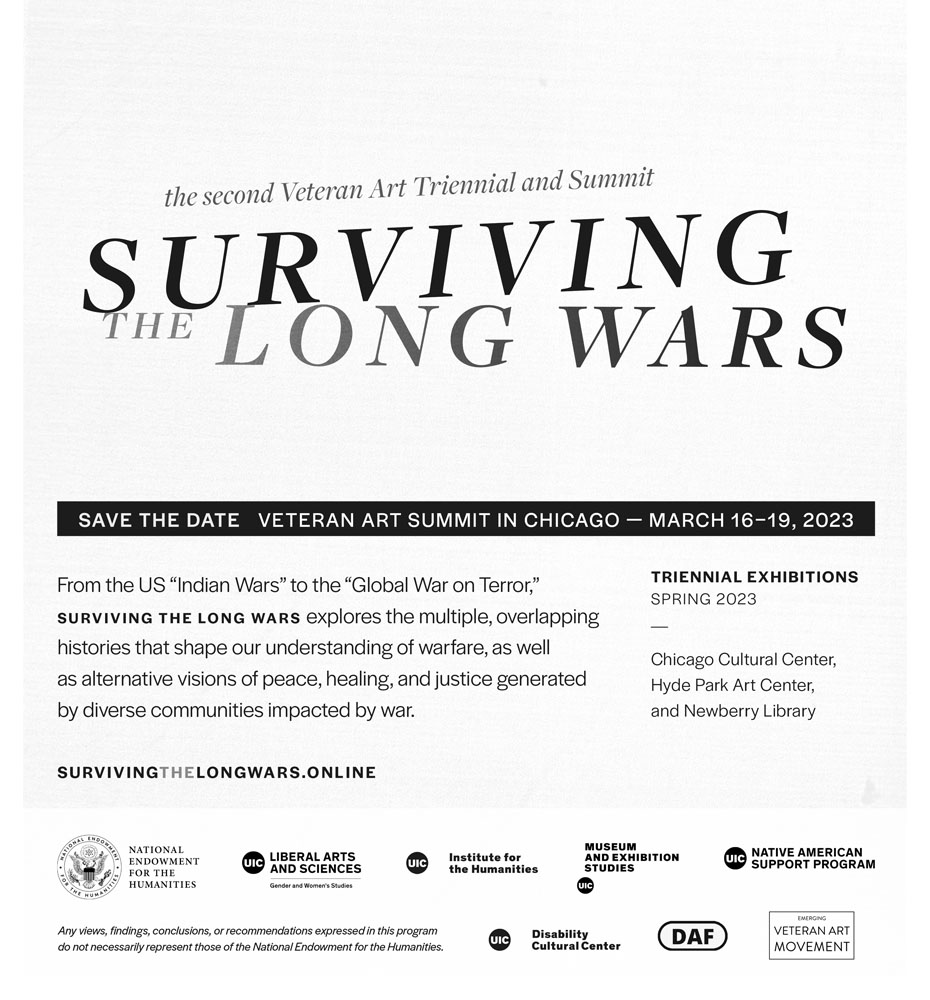 Download PDF of this full issue: v52n2.pdf (36.5 MB)
Download PDF of this full issue: v52n2.pdf (36.5 MB)From Vietnam Veterans Against the War, http://www.vvaw.org/veteran/article/?id=4147
 Download PDF of this full issue: v52n2.pdf (36.5 MB) Download PDF of this full issue: v52n2.pdf (36.5 MB) |
When you center the resistance of indigenous and the enslaved, and other victims of US counter insurgency interventions and wars around the world, you're in fact doing US history. And everything you thought you knew or theorized about the present and possible future melts into the air. The United States is a military state with an informally armed citizenry. — Roxanne Dunbar-Ortiz, Surviving the Long Wars, Scholarly Seminar, 2022.
This experience and realization is all too familiar to communities impacted globally by US warfare and many veterans who served in those wars. For those veterans, this realization creates conflict, particularly for Black, Indigenous, and People of Color (BIPOC) veterans who often embody contested identities that uphold Dunbar-Ortiz's point and the contradictions of American Exceptionalism. In response to this internal conflict, many have turned to creative expression as a tool to process, examine, and hold space for their involvement in military operations. This work creates opportunities for solidarity across differences and makes connections between visions of peace, healing, and justice.
An example of this is the collaborative work presented by Iraqi artists Wafaa Bilal and veteran artists Drew Cameron and Alicia Dietz in the Conflict Exchange (CX) installation at the first Veteran Art Triennial and Summit (VATS) in 2019. In this work they used military uniforms transformed into paper to help rebuild the University of Baghdad's art library. Surviving the Long Wars, the second Veteran Art Triennial and Summit set for Spring 2023, builds on this work and creates space for veterans to examine these complex identities, internalized contradictions, and histories represented in the space of art and culture. It also allows for dialogue with other, potentially more directly, impacted artists.
From the US "Indian Wars" to the "Global War on Terror," Surviving the Long Wars explores the multiple, overlapping histories that shape our understanding of warfare and visions of healing. The second VATS, is inspired by the powerful work, both historical and present, of Native American artists responding to the US "Indian Wars"and artists of the Greater Middle East reacting to the "Global War on Terror," It focuses on how these cultural responses complicate and entangle with the artistic practices of veterans.
For example, in an article in American Indian Magazine, the work of the legendary Native American artist and Vietnam war Veteran T.C. Cannon (Kiowa) was profiled. Cannon's dynamic 1970 figurative oil painting entitled Soldiers depicts one soldier split in two halves: one side of the soldier is illustrated in an army uniform and the other in indigenous warrior dress. In the magazine's estimation, the painting "shows just how divided Cannon felt about fighting in a war, with one half being the Native warrior and the other the colonizing soldier who oppressed his people."
Another example is Iraqi-American artist Michael Rakowitz, who in his piece The Invisible Enemy Should Not Exist uses Middle Eastern food packages, glue, and cardboard on wooden structures to paint an image that constructs reappearances of relief sculptures that were historically looted and destroyed by war and colonialism that lined the walls of the ancient Assyrian Palace of Nimrud (present day Mosul, Iraq).
These pieces of art address both the personal and collective transformations required to dismantle the "military state."
Through Surviving the Long Wars, the second Veteran Art Triennial and Summit creates dialogue around the conflicts, connections, and, most importantly, the unexpected solidarities that emerge when the artistic responses to the US "Indian Wars" and "Global War on Terror" are placed in conversation. Within this history, art and activism have long been linked with a tradition of peace and justice movements that are still apparent in the work of veteran artists today. Specifically, Surviving the Long Wars highlights the way BIPOC veterans have made art about their military experiences that challenge stereotypes, politics, and dominant media portrayals all while pointing to alternative futures.
Surviving the Long Wars encourages veterans, academics, and community members to think through the malleable symbolic and material parallels between the current "Global War on Terror" and the US "Indian Wars." The project begins with a virtual scholarly seminar series at the nexus of critical ethnic studies, Native/Indigenous studies, and Middle Eastern Studies. With a focus on the histories and futures of Native rebellion alongside contemporary US militarism and warfare. The first featured scholar is Roxanne Dunbar-Ortiz and additional scholars include Kyle T. Mays, Laleh Khalili, Harsha Walia, Nick C. Estes, Tiffany King, and Kelly Hayes. The project culminates in the second Veteran Art Triennial and Summit, in Spring 2023, at the Chicago Cultural Center, Hyde Park Art Center, and Newberry Library.
To learn more, visit us at www.survivingthelongwars.online.
Surviving the Long Wars is organized by Aaron Hughes, Ronak K. Kapadia, Therese Quinn, Joseph Lefthand, and Amber Zora.
Rachel Dukes is a Museum and Exhibition Studies graduate student at UIC. She serves as the Project Coordinator for Surviving the Long Wars.

|